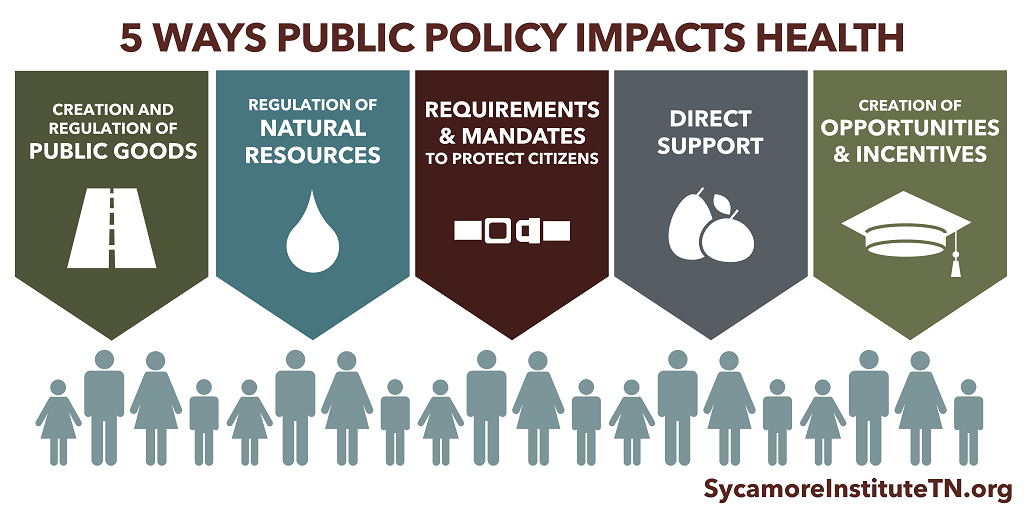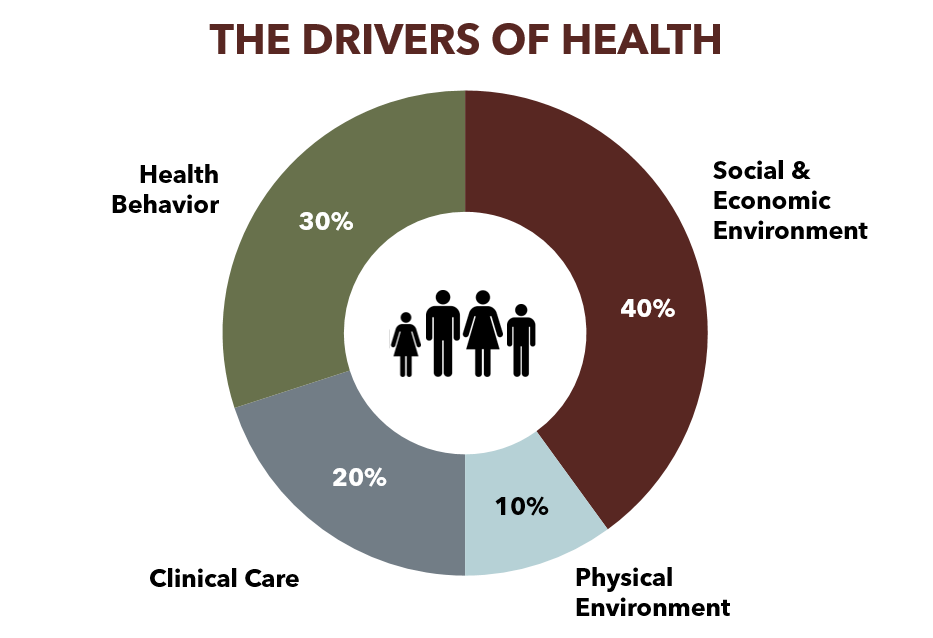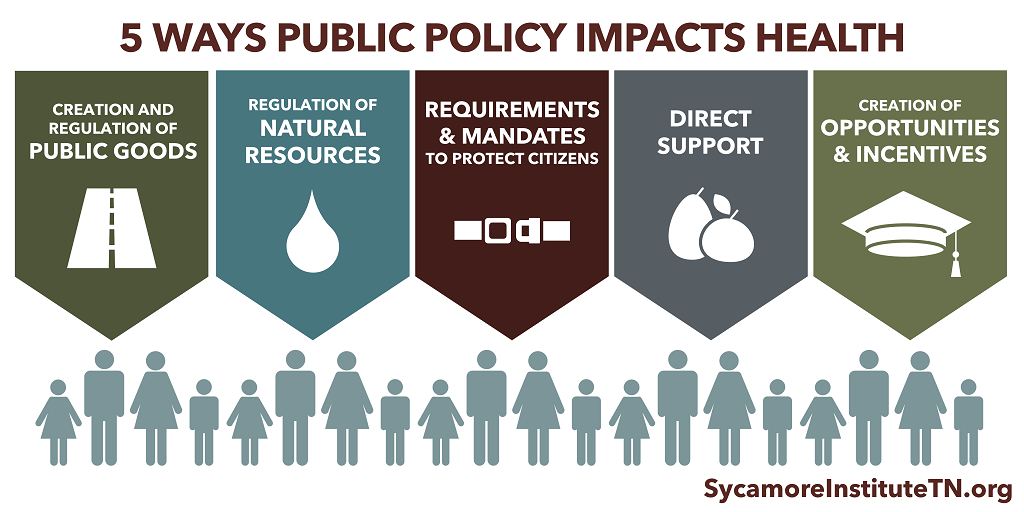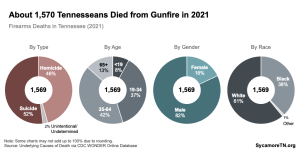
A Closer Look at the Intersection of Public Policy and the Drivers of Health
Health means more than just health care. While access to clinical care is a contributing factor, our behaviors and the physical, social, and economic environments in which we live, work, and play are also major drivers of health. (1) (2) (3)

As a result, health policy means more than just health care policy. In this post, we explain how a wide range of public policy issues — even some not usually associated with health — can influence the health and well-being of Tennesseans.
What Does Public Policy Do?
The realm of public policy is vast — it’s the system of laws, regulatory measures, courses of action (or inaction), and funding priorities implemented by a government entity or its representatives. While there may be debate about the proper size and role of government, public policies can and currently do play an important role in the everyday life of Tennesseans.
Health Policy: More Than Just Health Care Policy
Because clinical care is just one factor that influences health, health policy is more than just health care policy. By affecting the drivers of health, public policies that do not initially appear health-related can have a significant health impact. Tennessee’s public policies, programs, and services shape and influence our physical, social, and economic environments. They also create opportunities and incentives that influence Tennesseans’ behaviors.

5 Ways Public Policy Can Influence Health
While not always associated with health, the following 5 public policy areas can have a big health impact.
#1: Public policies can create, regulate, and maintain public goods that foster supportive environments for good health.
An example is our state roads and highways. They are funded by taxes and user fees and are open for use by anyone. How these roads are planned, constructed, connected, and maintained can, for example, impact the accessibility of needed services and the walkability of communities. These factors can create opportunities (or barriers) to getting the care and making the choices that keep people healthy. See How Transportation Impacts Public Health for more on this topic.
#2: Public policies can regulate natural resources to prevent harm.
For example, the Tennessee Department of Environment and Conservation regulates air and water quality to ensure it is safe. Many people take for granted that the air that they breathe and the water that they drink is safe and healthy, but exposure to pollution or contaminated drinking water contributes to health conditions like asthma and waterborne illness. (4)
#3: Public policies can set requirements and mandates that protect citizens.
For example, traffic accidents are a leading cause of fatalities and injuries. Mandatory seat belt laws were implemented to address this problem. These laws have increased seat belt usage and decreased the number of motor vehicle-related injuries and fatalities. (5) Laws against alcohol-impaired driving are another example of public policies designed to protect citizens.
#4: Public policies can provide direct support in ways that affect the drivers of health.
One example is the Temporary Assistance for Needy Families (TANF) program, which was created by the U.S. Congress in 1996. The program, known as Families First in Tennessee, is jointly funded by the state and federal governments and helps poor families gain self-sufficiency through employment. The program provides temporary cash assistance to help pay for basic needs like food, housing, and transportation while providing opportunities, requirements, and incentives for work training and employment. (6)
#5: Public policies can reduce barriers, create opportunities, or provide incentives that influence the choices that impact health.
One example of how public policy can create an opportunity to improve a driver of health is Tennessee’s HOPE scholarship. The HOPE scholarships are designed to reduce financial barriers and create the opportunity for some Tennessee students to attend college and attain a higher level of education. Research shows that education and income are the greatest predictors of health. Individuals with higher levels of education and income live longer and are healthier. (3) (7) (8) For more on this relationship, see How Education Influences Health in Tennessee.
Other policies may create financial incentives to make certain choices that lead to better health. For example, Tennessee imposes an excise tax on tobacco products. Research has shown that tobacco taxes may create a financial disincentive for some individuals to smoke. (9)
Parting Words
All policy decisions have trade-offs. As our state’s policymakers weigh these trade-offs, they should also consider how policies will affect the health and well-being of Tennesseans. Next week, we’ll take a look at the other side of the equation — how Tennesseans’ health can affect public policy.
References
Click to Open/Close
1. U.S. Health and Human Services Secretary’s Advisory Committee on National Health Promotion and Disease Objectives for 2020. Section IV: Advisory Committee Findings and Recommendations. Phase I Report: Recommendations for the Framework and Format of Healthy People 2020. [Online] https://www.healthypeople.gov/sites/default/files/PhaseI_0.pdf.
2. McGovern, Laura, Miller, George and Hughes-Cromwick, Paul. Health Policy Brief: The Relative Contribution of Multiple Determinants to Health Outcomes. Health Affairs. August 21, 2014. http://healthaffairs.org/healthpolicybriefs/brief_pdfs/healthpolicybrief_123.pdf
3. Woolf, Steven H. and al, et. The Health of the States: How U.S. States Compare in Health Status and the Factors that Shape Health, Summary Report. Virginia Commonwealth University’s Center on Society and Health and The Urban Institute. October 2016. http://www.urban.org/sites/default/files/publication/85211/health-of-the-states_1.pdf
4. Tennessee Department of Health. Healthy Places: Environmental Quality. [Online] 2017. https://www.tn.gov/health/cedep/environmental/healthy-places.html
5. Cohen, Alma and Einav, Liran. The Effects of Mandatory Seat Belt Laws on Driving Behavior and Traffic Fatalities. Harvard Law School Center for Law, Economics, and Business. 2001. http://www.law.harvard.edu/programs/olin_center/papers/pdf/341.pdf
6. Tennessee Department of Human Services. Families First. 2017. https://www.tn.gov/humanservices/topic/families-first-tanf
7. Goldman, Dana and Smith, James P. The Increasing Value of Education to Health. Social Science & Medicine. May 2011. https://www.ncbi.nlm.nih.gov/pmc/articles/PMC3119491/pdf/nihms295273.pdf
8. Woolf, Steven H et al. How are Income and Wealth Linked to Health and Longevity? . Urban Institute and Virginia Commonwealth University Center on Society and Health. 2015. http://www.urban.org/sites/default/files/alfresco/publication-pdfs/2000178-How-are-Income-and-Wealth-Linked-to-Health-and-Longevity.pdf
9. Woolf, Steven H and Braveman, Paula. Where Health Disparities Begin: The Role of Social and Economic Determinants And Why Current Policies May Make Matters Worse. Health Affairs 30(10). http://content.healthaffairs.org/content/30/10/1852.full

















